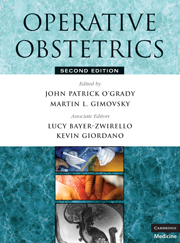Foreword
Published online by Cambridge University Press: 07 May 2010
Summary
THE PROCESS OF EVOLUTION affects not only the characteristics of a species but also the adaptive technology between a species and its environment. The practice of obstetrics is devoted to maximizing the ability of each human being to confront the environment and to be part of the creative, modulating path of evolution. It is almost, if not totally, impossible to discern evolutionary human changes within our own lifetimes; however, it is a different story with the technology of our interactions. Obstetrics has changed, and it has changed rapidly.
If the earth's lifetime were compressed into a single 24-hour day, humans would have appeared only 30 seconds ago. I cannot imagine what nanocalculation would be required to measure the history of operative obstetrics, yet that incredibly short measure of geologic time is packed with a geometrically increasing collection of events and stories. The interesting and comprehensive chapter on the history of operative delivery alone is worth the price of this book. Every contemporary obstetrician should know and learn from the history of obstetrics. Some might argue that this history is truly the past, and that operative obstetrics today is a matter of a few simple choices. Even that judgment, however, must be based on a critical analysis of the operative choices. Only then can the individual obstetrician understand the reasons behind modern decisions.
The modern focus on “evidence-based medicine” all too often fails to recognize the broad base of knowledge that is the foundation of clinical decision making.
- Type
- Chapter
- Information
- Operative Obstetrics , pp. xi - xiiPublisher: Cambridge University PressPrint publication year: 2008



